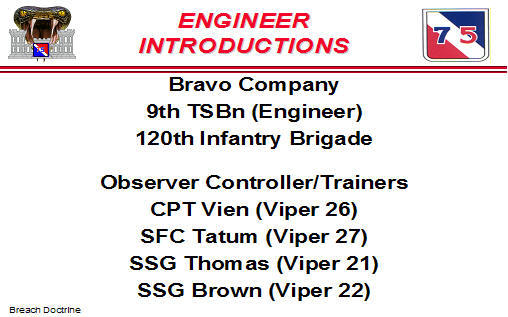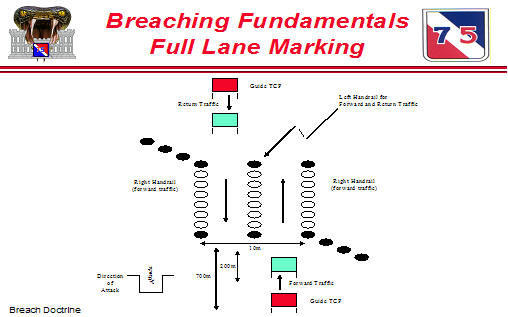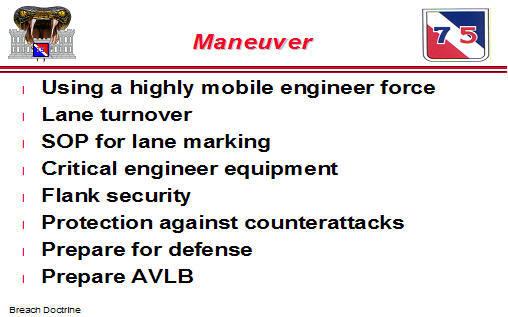Breaching Doctrine
Click here to download the presentation.



ENGINEER INTRODUCTIONS
Bravo Company
9th TSBn (Engineer)
120th Infantry Brigade
Observer Controller/Trainers
CPT Vien (Viper 26)
SFC Tatum (Viper 27)
SSG Thomas (Viper 21)
SSG Brown (Viper 22)
9th TSBn (Engineer)
Website
COM: (254) 287-1286
DSN: 737-1286
FAX: (254) 288-4069
Outline
Introduction
Breaching Doctrine
Validation of Task (In-Stride Breach)
Engineer Exercise Rules of Engagement (EXROE)
Practical Exercise
Summary
Breaching Doctrine
Breaching Tenets:
Intelligence
Breaching Fundamentals
Breaching Organization
Mass
Synchronization
Maneuver
Types of Breaching Operations
Planning Sequence
Intelligence
“See the Battlefield”
Intelligence Preparation of the Battlefield (IPB)
Priority Intelligence Requirement (PIR)
Obstacle Intelligence (OBSTINTEL)
Obstacle location
Obstacle Orientation
Presence of wire
Gaps and Bypasses
Minefield Composition
Types of mines
Location of enemy direct-fire weapons
Intelligence
Named Areas of Interest (NAI)
Target Areas of Interest (TAI)
Reconnaissance
Breaching Fundamentals
SOSR
Breaching Fundamentals
SUPPRESS:
Neutralize or destroy the defender’s weapons with our own fires:
3:1 Force Ratio
Weapons Effects/Characteristics
Focus of Direct/Indirect Fires, Electronic Countermeasures and Directed Energy
Timely Shift and Lift
Breaching Fundamentals
OBSCURE:
Hamper the enemy’s observation and target acquisition:
Smoke (Indirect, Onboard, Pyrotechnic)
Terrain
Breaching Fundamentals
SECURE:
Eliminate enemy interference with obstacle reduction and lane usage:
Identify Enemy Defenses
By Occupation with a Force
Breaching Fundamentals
REDUCE:
Creating, marking and reporting lanes through, over or around an obstacle:
1 lane per Company Team
2 lanes per Task Force
Mounted Explosive
Mounted Mechanical
Dismounted Manual
Dismounted Explosive
Breaching Fundamentals
Initial Lane Marking
Breaching Fundamentals
Intermediate Lane Marking
Breaching Organization
Support Force
Breach Force
Assault Force
Breaching Organization
SUPPORT FORCE:
Eliminate enemy interference
Isolate the battlefield
Mass fires
Control obscuring smoke
First priority of force allocation
Ratios
Breaching Organization
BREACH FORCE:
IS a combined arms force
Creates, marks and reports lanes in the obstacle
Locally secures the breach site
Provide own suppression
Provide own smoke
Passes the assault force
Breaching Organization
ASSAULT FORCE:
Destroys or dislodges the enemy force on the far side of the obstacle
Seizes the initial foothold on the objective
May assist support force during breach
Other forces lift and shift fires from the objective
3:1 Ratio
Mass
Concentrated force against weakness
Engineers and breaching assets
Reduction effort
Balance assets and needs
Synchronization
SOSR
Fundamentals
Detailed reverse planning
Clear subunit instruction
Effective command and control
A well-rehearsed force
Synchronization
Maneuver
Using a highly mobile engineer force
Lane turnover
SOP for lane marking
Critical engineer equipment
Flank security
Protection against counterattacks
Prepare for defense
Prepare AVLB
Types of
Breaching Operations
In-Stride
Deliberate
Assault
Covert
Bypass
The FIRST option considered
May put force in JEOPARDY; may accomplish the enemy’s obstacle intent
Good RECON is essential to successful bypass operations
Maximum SECURITY during bypass operations
Types of
Breaching Operations
INSTRIDE:
Unclear situation
Enemy defense
Synchronize SOSR
Mission
Support, breach and assault forces
Most common
Types of
Breaching Operations
INSTRIDE:
Planning
Preparing
Executing
Types of
Breaching Operations
DELIBERATE:
“After in-stride Fails”
Force allocations
Breaching fundamentals
Planning
Preparing
Execution
Brigade level
Types of
Breaching Operations
ASSAULT:
Protective obstacles
Mission
Nature of the Assault
Fundamentals
Types of
Breaching Operations
ASSAULT:
Engineer integration
Consolidation
Types of
Breaching Operations
COVERT:
Undetected movement
Surprise
Limited visibility and terrain
Combat power
Fundamentals
Planning
Preparing
Validation of Task
(In-Stride Breach)
ELEMENT: PLATOON
TASK: CONDUCT an in-stride breach of a minefield (05-3-0103) (FM 90-13-1, FM 5-250, FM 20-32, FM 5-34)
Validation of Task
(In-Stride Breach)
CONDITION: The engineer platoon, in support of a maneuver force conducting an in-stride breach, is directed to reduce a minefield. The maneuver force commander designates support, breach, and assault forces. The minefield has been located and reconnoitered. The mines are surface laid and/or buried. Antihandling devices may have been used. The minefield is 120 meters deep, surface laid and/or buried, and covered by direct and/or observed indirect enemy fire.
Validation of Task
(In-Stride Breach)
TASK STANDARD: The platoon creates and marks lanes through the minefield to maintain the momentum of the tactical operation. The platoon creates the lanes within 10 minutes if the obstacle is covered by direct fire and/or observed indirect enemy fire. Friendly forces sustain no casualties from using the marked lanes.
Validation of Task
(In-Stride Breach)
VALIDATION: 12 November 1998 by 9th TSBn (Engineer) and changes are bolded.
Validation of Task
(In-Stride Breach)
*+1. The platoon leader advises the breaching force leader on the location, size, and number of lanes to be created (01-1920.00-0012).
a. Determines the lane location based on terrain, cover and concealment for the breaching force, time, and equipment available for the breach and the maneuver scheme.
b. Determines the lane size based on the time allowed for the unit and the equipment which must pass through the lanes. The minimum desired widths are 1 meter for a footpath (dismounted troops) and 4.5 meters for an initial lane to pass vehicles/equipment conducting the attack.
c. Determines the number of lanes based on the size of the unit to pass through the minefield. A minimum of one lane is required for a maneuver company and a minimum of two lanes for a task force.
Validation of Task
(In-Stride Breach)
*+2. The platoon leader, in coordination with the breaching force leader, selects the means for reducing the minefield.
a. Uses explosive line charges.
(1) The M58A4 mine clearing line charge (MICLIC) clears a lane 14 meters by 100 meters. The MICLIC is normally employed in pairs, unless the limits of the minefield (for example, front edge) are well known and the minefield depth is less than 100 meters.
(2) The Antipersonnel Obstacle Breaching System (APOBS) clears a lane 0.6 meters by 45 meters. The APOBS is a dismounted two soldier-team carry. It has a 25 meter standoff for antipersonnel mines and wire entanglements.
Validation of Task
(In-Stride Breach)
b. Uses manual means with/without explosives.
(1) Destroys mines with hand-emplaced explosives.
(2) Destroys mines with a bangalore torpedo. The bangalore torpedo is placed directly next to a mine to detonate it. Bangalore torpedoes are effective in creating a footpath but limited in creating a vehicle path. To create a vehicle lane, bangalore torpedoes must be placed over the top of the furrow created by mechanical minelayers, in order to detonate the mines underneath. Use this method as a last resort when breaching antitank minefields.
Validation of Task
(In-Stride Breach)
c. Uses mechanical reduction techniques (if available).
(1) Creates lane with a mine clearing blade (MCB) mine plow.
(2) As a last resort, uses the combat engineer vehicle (CEV) (if available) or M9 armored combat earthmover (ACE) to create a lane by the skimming technique.
Validation of Task
(In-Stride Breach)
3. The platoon creates the required lane(s) using the selected reduction technique.
+a. Creates a lane within 10 minutes if the obstacle is covered by direct and/or observed indirect fire. No time standard is established if the obstacle is not covered by fire or if the platoon is conducting stealth breaching and is not detected by the enemy.
Validation of Task
(In-Stride Breach)
b. Creates a lane using an explosive line charge.
(1) Employs line charges in pairs, unless the limits of the minefield are well known, since most enemy minefields will be deep enough to counter the length of the line charge. If minefield is less than 100 meters and edge is known, the standoff is 62 meters.
(2) Positions the line charge to allow sufficient standoff to compensate for the length of the inert cable to ensure the line charge covers the suspected forward edge of the minefield. If minefield is greater than 100 meters and edge is unknown or there is a disabled vehicle, the standoff is 100 meters.
(3) Positions the second line charge moving 25 meters into the burn mark of the first charge for appropriate overlap. Aligns it with the first line charge.
Validation of Task
(In-Stride Breach)
c. Creates a lane manually by using explosives (surface laid minefield).
(1) Places M1A2 bangalore torpedoes directly next to the mines. Uses this method as a last resort when breaching antitank minefields.
(2) Places one pound hand-emplaced charges directly next to the mines. May prime the demolitions and detonate the mines in place as they are detected, or may connect individual charges into a ring main or line main and simultaneously detonate to save time.
Validation of Task
(In-Stride Breach)
(3) If members detect or suspect trip wires, they clear them using grapnels or clearly mark them so personnel placing explosives do not activate them.
(a) Requires all personnel to take cover or lie in a prone position at least 60 meters from the mine. Throws the grapnel or, if removing a mine, attaches a rope, wire, or grapnel to the mine. Pulls the rope or wire from the covered position after moving rearward until rope is at 60 meters.
(b) Uses the weapon-launched grapnel hook (WLGH) to clear tripwires. The firer is 25 meters from the leading edge of the minefield with the weapon oriented at a 30- to 40- degree angle. The grapnel will travel 75 to 100 meters and the firer moves rearward an additional 35 meters and begins to grapnel from a covered position.
Validation of Task
(In-Stride Breach)
d. Manually creates a lane by using explosives (buried minefield).
(1) If the mines were buried by a mechanical minelayer and the furrow is visible, places M1A2 bangalore torpedoes directly over the mine furrow for each row of mines in the minefield. The length of bangalore sections is equal to the desired width of the lane. The minimum number of sections for a 4-meter lane is three.
(2) Detects the mines by the visual method, probing, or electronic detectors. Marks mines and destroys in place using explosives. If personnel encounter trip wires, they are cleared with grapnel hooks.
Validation of Task
(In-Stride Breach)
e. Manually creates a lane without explosives.
(1) For surface laid minefields, uses the grapnel to remove mines/trip wires. Requires all personnel to take cover or lie in a prone position at least 60 meters from the mine. Throws the grapnel or, if removing a mine, attaches a rope, wire, or grapnel to the mine. Pulls the rope or wire from the covered position after moving rearward until rope is at 60 meters.
(2) Does not use this technique for creating a lane in a buried minefield.
Validation of Task
(In-Stride Breach)
f. Creates a lane using a fabricated or MCB mineplow for surface laid and buried minefields. Employs the plow a minimum of 100 meters prior to the suspected or known forward edge of the minefield. Continues using the mineplow at least 100 meters beyond the far edge of the minefield.
Validation of Task
(In-Stride Breach)
g. Creates a lane using the skimming technique (surface-laid minefields only).
(1) Uses engineer equipment such as earth moving blades of the CEV (if available) or the ACE to create vehicle lanes.
(2) Uses the skimming techniques as a last resort due to probable loss of valuable engineer assets.
(3) Uses the skimming process. Pushes the top 21,25, or 31 centimeters of soil. Does not let the build up go over or under the blade; alternates strikes to the left and right sides of the desired lane. This is a dangerous and time-consuming method.
Validation of Task
(In-Stride Breach)
h. Uses special procedures when chemical mines are known or suspected to be present.
(1) Ensures all personnel operating within the downwind area have implemented mission oriented protective posture (MOPP) level 4.
(2) Equips breaching teams with a chemical agent detector kit or automatic chemical alarm. Ensures each team has trained and proficient operators.
(3) Ensures the teams do not detonate chemical mines in place.
Validation of Task
(In-Stride Breach)
*+4. The platoon marks the cleared lane(s). As a minimum, marks lane using initial marking. See FM 90-13-1 Appendix E.
a. Places final approach marker.
b. Places entrance funnel.
c. Places entrance markers.
d. Places left handrail.
e. Places exit markers.
Validation of Task
(In-Stride Breach)
*+5. Friendly forces sustain no casualties from using the marked lanes.
a. Lane is properly marked.
b. No mines encountered in marked lane.
*+6. The platoon leader reports the lane(s) location to higher headquarters IAW the unit SOP.
Engineer EXROE
Engineer EXROE
Obstacle Breaching Methods
MOUNTED EXPLOSIVE:
MICLIC training rocket must be allocated for use by the unit; if training aid with rocket is not available, prior coordination with OC/Ts must be made.
Engineer EXROE
Obstacle Breaching Methods
MOUNTED MECHANICAL:
Mechanical breaching systems include: mineplows, rollers, rakes and blades.
OC/Ts on site will determine effectiveness of the mine clearing operations based on types of mines, depth and soil conditions.
Units may use mineplows to breach conventional and FASCAM minefields.
Units should use mine rollers to detect minefields and proof lanes.
Units may use vehicles with blades to skim surface laid conventional or FASCAM mines.
Engineer EXROE
Obstacle Breaching Methods
DISMOUNTED MANUAL:
Units may use manual breaching techniques to breach wire and minefields.
Improper manual breaching will be assessed by OC/Ts.
Exposed personnel within 25 meters will become casualties.
Grappling hooks may be used to drag wire or clear a footpath through OPFOR mines.
Engineer EXROE
Obstacle Breaching Methods
DISMOUNTED EXPLOSIVE:
Units using explosive breaching techniques must have all appropriate demolition materials: MDI, fuze igniters, det cord, and training aids.
Units must place demolitions next to a conventional mine and detonate the demolition to destroy the mine.
To breach FASCAM minefields, units must first ensure that they have a cleared footpath using a grappling hook and bangalore torpedo.
Once the simulated explosive breach has been correctly executed, OC/Ts will allow units to cut wires and remove mines from the breached lane.
Engineer EXROE
Battle Damage Assessment
OC/Ts assess all mines emplaced by BLUFOR and OPFOR.
Detonation of antipersonnel and/or antitank mines
Yellow smoke grenade
Grenade simulator
Breaching antipersonnel and/or antitank mines
Yellow smoke grenade
Engineer EXROE
Demolitions
All training demolitions materials will be handled as live demolitions.
DES will be used during all exercises.
Live demolitions may be used for tactical operations (OC/Ts must be present) and be used in approved areas.